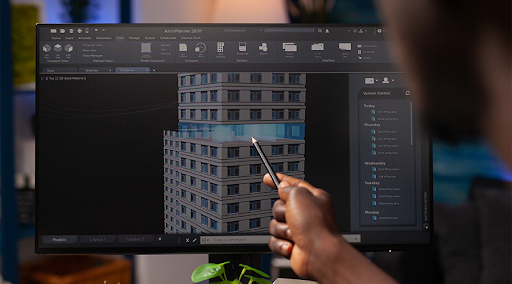Overview and Benefits of Building Information Modelling Software

Building Information Modelling (BIM) digitizes the entire building process, revolutionizing the facilities management and construction industries. It includes 3D models enhanced with data attributes, going beyond conventional 2D drawings and plans. Building Information Modelling (BIM) includes not just a building’s external features but also its functional attributes, performance metrics, and lifecycle data. Stakeholders may visualize, analyze, and simulate different situations using an all-inclusive approach, which facilitates informed decision-making and maximizes building performance.
Building Information Modeling (BIM) is a tool that makes different characters of information about buildings, operations, and maintenance of facilities united in the context of facility management. Design and construction stage-related vital information, including structural details, mechanical systems, electrical layouts, architectural drawings, and material requirements, is gathered by it. Communicating in real-time data streams like sensor data, IoT devices, and maintenance logs will give a comprehensive picture of the building’s functionality and health together.
Facility managers can even use BIM to make a building’s overall user experience better, manage resources more efficiently, and make a building operation easier daily. Facilities management teams may be able to ensure the seamless functioning of building systems, smooth workflow, and resolve issues before they even arise through the utilization of digital models and data analytics. The facility managers may now make decisions based on data that is in tune with the organizational goals, sustainability programs, and the requirements of the law thanks to BIM use.
What is the scope of BIM in Facility Management?
BIM for facility management is a process that covers the entire life cycle of a building: from designing and construction to maintenance. It includes the production and use of digital models which are designed with the data on all parts and maintenance processes power consumption and all other aspects of the facility. Executives in charge of facilities may make informed decisions, reduce complexities, and effectively use resources with the help of this information.
BIM is a major game changer for facility management due to its multiple advantages.
Improved Collaboration:
In a BIM, cooperation of all the different entities such as architects, engineers, contractors, and facility managers is promoted. Elimination of errors and improvement of cross-team collaboration can be brought about by having a digital model as a central site for project data.
Enhanced Decision-Making:
Facility managers will be able to make informed decisions about maintenance, repairs, and upgrades of building systems by using the data collected on the building’s systems and functional components. Through the maintenance of a proactive stance, less downtime is recorded and therefore, the asset lifespan is increased.
Cost Savings:
At every stage of such a structure, BIM provides cost-effective and resource-saving strategies. As a tool, BIM assists facilities managers in saving money over the long term by anticipating maintenance issues and pinpointing more energy-efficient solutions.
Streamlined Maintenance:
Different items, including timetables, equipment specifications, and maintenance records are just a few of the many BIM views of building maintenance needs. This is an added advantage that enables maintenance to be planned and performed in advance, and this reduces the amount of unnecessary downtime and emergencies.
Enhanced Sustainability:
The application of sustainability principles to facility management procedures is made easier by BIM. BIM helps with sustainable building operations by evaluating energy use, spotting inefficiencies, and putting eco-friendly solutions in place.
Asset Performance Management:
Facility managers may track performance data, spot patterns, and maximize asset performance with the help of BIM’s real-time building asset monitoring. This proactive strategy reduces interruptions and guarantees peak performance.
Compliance and Regulatory Management:
Compliance with industry standards, laws, and building rules is ensured with the use of BIM. Facility managers can expedite audits and inspections by keeping the digital model updated with appropriate paperwork and regulatory data.
Facility management has been completely transformed by Building Information Modelling (BIM), which provides a wealth of advantages including increased decision-making, collaboration, cost savings, sustainability, and regulatory compliance. At UPSFM, we use building information modeling (BIM) to provide outstanding facility management services that guarantee effective operations, preventative maintenance, and maximize building performance. For additional information on how we use technology to revolutionize the way you manage your facilities, go to UPSFM. Today, discover the UPSFM distinction!
Have any feedback or questions?
Contact us!




